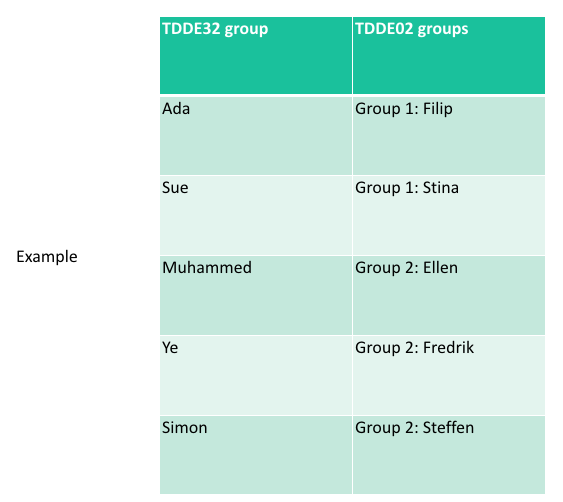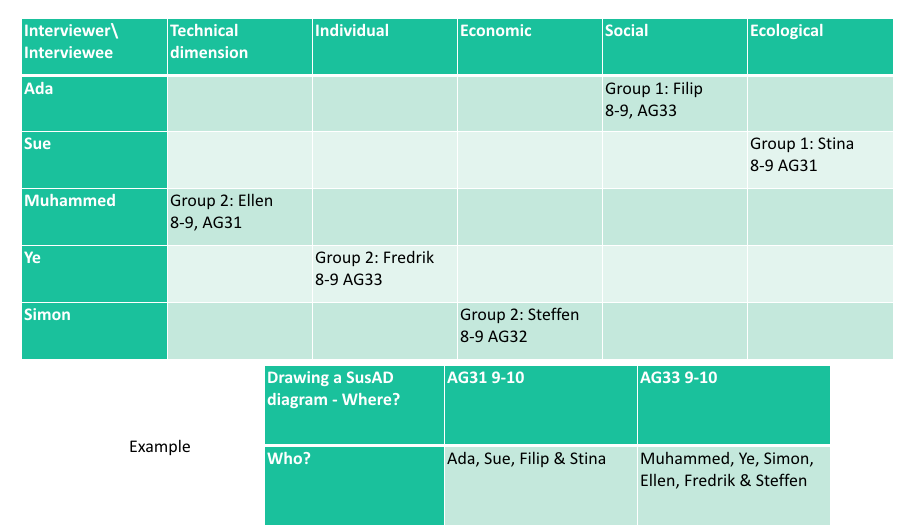TDDE32 Professionalism in Computer Science
SusAD assignment in TDDE32 and TDDE02
Assignment
This assignment is a joint assignment for students in courses TDDE32 - "Professionalism in Computer Science" and TDDE02 - "Software Entrepreneurship" (in Swedish). You will do preparations, engage in a joint activity of conducting a series of interviews, drawing a diagram to describe the outcome and reporting on the results.1. Preparations
- Read the paper "Requirements: The Key to Sustainability" from IEEE Software to understand the background to using this method for analyzing the effects of software systems.
- Study the questions that you will be using.
- Look at the examples provided for a sustainable procurement system and for Airbnb.
- During the introductory lecture 2019-11-20 13-15, you will get to practice with a colleague before your interviews.
- Finally, you will need to book times for interviews and drawing a diagram together. Each student in TDDE32 will need to interview a student from TDDE02. You get to decide which dimensions to cover with your interviews, but each interview will cover exactly one of the dimensiobns. Thus, make sure that you divide the dimensions among yourselves so that each dimension of the ones you have chosen is covered exactly once. E.g., if there are two members of a project group in TDDE02, you choose two of the five dimensions to conduct interviews on such as the ecological and technical. If there are three members, you choose three dimensions.
2. Interviews
You will need to participate in interviews on the wider implications of IT systems, regarding possible technical, individual, economic, social and ecological effects of IT systems. In each interview, a student from TDDE32 will ask questions and a student from TDDE02 will try to answer them to the best of their ability. The questions and detailed instructions for how to use them is available in the material folder. In some cases, a person may have to conduct more than one interview. It will require 45 minutes to 1h per interview, and each student in TDDE02 will have to be interviewed on one of the dimensions. If there are fewer than five students in each group in TDDE02, you will need to decide which of the five dimensions you should ask questions about.For TDDE32 students, you need to:
- ensure each TDDE02 student is interviewed once.
- Follow the instructions on the Question Sheets and take notes during the interviews in the Notes Taking forms provided. Remember that the interviewee will see your notes. So, write clearly.
- Remember that the interview is not about identifying one or two effects, it is about engaging in a conversation with the interviewee. As an analyst, you should make the interviewee reflect on the different scenarios. Use the "Remind participants to consider..." section of the Question sheets.
For TDDE02 students:
- Explain the system to the TDDE32 students
- Answer the questions asked by the TDDE32 students.
3. Drawing a diagram
After all appropriate interviews for a project in TDDE02 have been conducted, both interviewing students from TDDE32 and TDDE02 students will need to draw a SusAD diagram together on a whiteboard or large sheet of paper.- Please read the instructions to draw the SusAD.
- Draw a SusAD for the most interesting chains of effects.
- For the remaining potential effects and chains of effects, note them in text form, indicating the dimension and order of effect. For example:
- Social/Sense of community: "Pre-approved-suppliers" (technical, immediate) -> purchase always from the same provider (economic, enabling) ->higher entry barrier for new businesses (economic, systemic) -> concentration of wealth (economic, systemic) -> unequal society (social, systemic)
- All issues must be captured, even the ones that do not have a chain associated to it.
4. Reporting your results
For TDDE32 students:- Take a picture with the finished SusAD diagram and include as reference of your activity and as documentation that you have conducted the activity. This shall be included in your essay.
- TDDE32 students will add a section to their essary and reflect on the outcome according the instructions for writing the TDDE32 essay.
- Take a picture of the finished SusAD diagram and include as reference of your activity and as documentation that you have conducted the activity. The picture can be included in your report.
- TDDE02 students will have to use the outcome of this activity as part of their project according to the instructions given on the TDDE02 examination page (in Swedish).
SusAD Material folder
The SusAD material folder contains instructions for you to read in preparation to holding interviews and drawing diagrams.Groups
You will conduct interviews where each of the students in TDDE32 participates in interviewing students from TDDE02. Based on how many groups there are in TDDE02, you will need to divide yourselves so that each group in TDDE02 is interviewed by students from TDDE32. Once TDDE02 teams have been formed, we will update this page with information on the actual teams and combinations of students from both courses.| TDDE02 | TDDE32 | ||
| G01 | Anton Orö (antor907) | Grupp 1 | Sajawal Khan (sajkh857) |
| Rasmus Karlbäck (raska260) | Grupp 3 | David Grönberg (davgr686) | |
| Carl Lidman (carli625) | Grupp 4 | Mladen Nikic (mlani140) | |
| G02 | Gabriel Markfjärd (gabma047) | Grupp 3 | Arturas Aleksandrauskas (artal938) |
| Gustav Andersson (gusan092) | Grupp 2 | Miaoling Shi (miash554) | |
| Johan Runestam (johru036) | Grupp 1 | Yunhee Kim (yunki172) | |
| Oscar Bergman (oscbe086) | Grupp 5 | Lawrence Thanakumar Rajappa (lawra776) | |
| G03 | Johan Can (johca907) | Grupp 2 | Karl Söderbäck (karso527) |
| Diba Rezaie (dibre338) | Grupp 3 | Bilal Yasin (bilya816) | |
| Lisa Habbe (lisha157) | Grupp 1 | Vera Antonov (veran441) | |
| Daniel Keyvanpour (danke121) | Grupp 5 | Shahin Salehi Marzi Jarani (shasa714) | |
| G04 | Sofie Liljedahl (sofli181) | Grupp 2 | Talha Aziz (talaz151) |
| My Norsbo (myno940) | Grupp 4 | Joakim Kahlström (joaka568) | |
| Arin Rashid (arira675) | Grupp 1 | Merajul Islam Juman (merju341) | |
| Alexander Andersson (alean742) | Grupp 3 | August Johnson (augjo318) | |
| G05 | William Holmgren (wilho369) | Grupp 5 | Erik Lindgren (erili040) |
| Martin Lindblom (marli733) | Grupp 1 | Della Baby (delba753) | |
| Tim Hellberg (timhe442) | Grupp 4 | Bilal Ahmed (bilah120) | |
| Kristoffer Sandberg (krisa322) | Grupp 2 | Muhammad Ismail (muhis511) | |
| G06 | Madeleine Bäckström (madba061) | Grupp 4 | Grégoire Vola (grevo149) |
| Mimmi Cromsjö (mimcr147) | Grupp 3 | Rauf Ahmad (rauah140) | |
| Linn Hallonqvist (linha255) | Grupp 1 | Muhammad Yaseen (muhya577) | |
| Grupp 1 | Muhammad Moeez Afzal (muhaf586) | ||
| G07 | Alexander Vestin (aleve030) | Grupp 3 | Kyriakos Domanos (kyrdo817) |
| Simon Sundberg (simsu451) | Grupp 5 | Yahaya Usman (yahus591) | |
| G08 | Björn Möller Ehrnlund (bjoeh523) | Grupp 4 | Ammar Ali (ammal076) |
| Niklas Granander (nikgr117) | Grupp 5 | David Nyberg (davny376) | |
| Filip Ström (filst881) | Grupp 2 | Sogol Sattarzadeh (sogsa078) | |
| G09 | Axel Nordanskog (axeno840) | Grupp 5 | Aditya Pankaj Thanekar (adith054) |
| Gustaf Söderholm (gusso811) | Grupp 4 | Muhammad Nauman Anjum (muhan023) |
Example
Here is an example of how the group interviews may be arranged. Note that the times and locations will have to be decided by members of the groups from TDDE32 and TDDE02.

Page responsible: Arne Jönsson
Last updated: 2019-11-15

